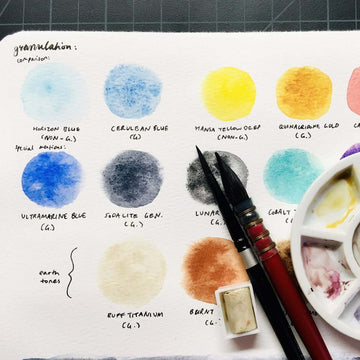As you’re expanding your watercolour paint collection, you may have noticed that a few colours consistently produce a speckling effect.
Whether you love it or hate it, granulation is inherent in and unique to watercolour. Let’s take a closer look – both figuratively and literally!
A Pigment Property

In their purest form, most watercolours are made of pigment(s) and binders. Artists in the past would use organic pigments, usually from different soils, rocks, or flowers.
After grinding these pigments, a binder like gum arabic or honey is added to turn it into a paint-like consistency.
Today, we manufacture most pigments, but the type of pigment used is always what causes granulation. Granulation happens when the pigment’s particles are still heavy and large enough to be seen on paper and form tiny “clumps” of colour, producing that speckled effect.
Granulation happens because some pigments are more difficult to grind into a fine powder, which is why you’ll notice specific colours tend to granulate no matter what brand of paint you use.
Other pigments – usually manufactured dyes – never granulate because they’re made from chemical processes, which require little to no grinding. These pigments will produce consistently smooth washes no matter what type of paper you use.
We've got a great article on Watercolour Pigments if you want to learn more about them.
To check if a paint granulates or not, grab a sheet of watercolour paper and do a quick swatch. If you see a speckly or mottled effect, then it’s a granulating colour.
In the first row of paint swatches seen in the image above, I compare granulating and non-granulating colours side-by-side. The non-granulating paints look much smoother compared to the granulating ones.
Tip: I recommend using cold press paper here because the rougher texture allows for more settling of pigment particles, which enhances the granulating effect. You may also notice that it’s more difficult to see granulation in lighter colours and that some colours only partially granulate.
Bonus tip: Many watercolour manufacturers label their paints, and some even go the extra step saying whether or not they granulate with a simple “G” for “Granulating”. Check out this blog to learn all about watercolour labels.
Special Mentions

If you have a big enough paint collection, you’ll begin to notice that specific colours are often granulating colours and that they tend to be in the blue-purple range. These include (but aren’t limited to):
- Cerulean Blue
- Ultramarine Blue
- Prussian Blue
- Cobalt Violet (or most Cobalt colours)
Earth tones are often granulating colours, too, like:
- Yellow Ochre
- Burnt Sienna
- Burnt Umber
On the opposite end of the spectrum, yellows and reds usually aren’t granulating, though this depends on the pigment and brand of paint you use.
Greens mix blue and yellow pigments, so they may or may not granulate depending on which pigments are mixed.
Last but not least, black paints tend to be granulating too! It’s just harder to see the more saturated your paint is, so when checking for granulation, try to use a little more water than you usually would.
Don’t Hesitate to Granulate

If you’re absolutely in love with granulation, there are several ways to bring it out more effectively. I’ve already mentioned one – using cold press paper instead of the smooth hot press paper.
Another way is to use only paints that granulate. Often, paint made from rock-based pigments will granulate but are more expensive.
A clue for spotting these pigments is in their name – it will contain the name of the rock, such as jadeite, amethyst, and chromium. (Makes sense, as rocks are pretty hard to grind!)
If you prefer less costly paint, using the “wet-in-wet” technique (i.e. adding paint to a wet surface) is an excellent way to encourage the particles to separate before settling, causing a more apparent granulating effect.
Last but not least, sometimes the best granulating effects are caused by a “happy accident” – that is, when you get a backrun or bloom in your painting. If you ever get one that looks amazing, do your best to preserve it!
Bonus tips: You can add granulation to non-granulating watercolours by mixing them with granulating paint. It won’t be as pronounced, but it will still work (though the resulting colour can be quite different depending on which colours you mix).
Another helpful thing is laying your painting surface flat, helping the pigments spread more evenly, rather than pooling towards the bottom.
Granulate Like Sugar

Granulation is unique to watercolours, so it is worth exploring; even if you’re not a huge fan, you’ll have a deeper understanding of the medium. Granulation can add an organic, whimsical touch to a painting simply because it’s out of the artist’s control.
Of course, you don’t have to use it for the entire painting. I prefer to be a little more selective where I want granulation to happen – mostly when painting skies, seas, or anything that would benefit from a “happy accident”!
Now you have a better understanding of granulation and a bit more insight into the world of watercolour. If you want to learn more about watercolour, I highly suggest that you check out our Introduction to Watercolour course!
Do you like granulating watercolours? Have you experienced any “happy accidents” involving granulation before? Share your experience with us in the comments!
Also, if you’d like more tips and tricks about art or want to keep up to date with product releases and sales, feel free to subscribe to our email newsletter.



1 comment
I have been having fun with granulating colors. Mountain rocks stand out when granulated. Anywhere that I want a textured surface is a prime candidate.
———
Etchr Lab replied:
Glad to hear you’re having fun with granulating colours, Lee! 🧡